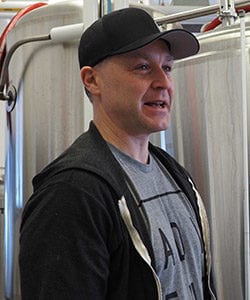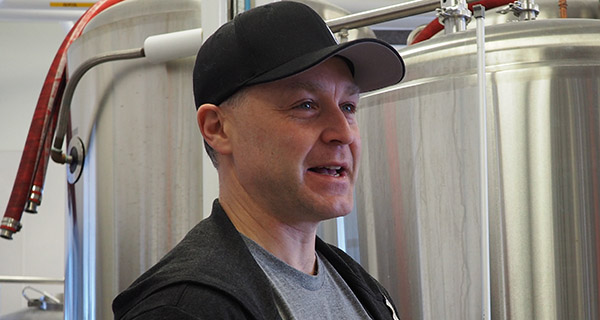Bill Robinson is president of Alberta Beer Festivals.

Bill Robinson
Why has the craft beer business in Alberta exploded in the past few years?
Robinson: There are a few reasons we have seen such an explosion in the craft beer industry here in Alberta over the past few years. When you think about the fact that we had 15 breweries five or six years ago, and today, if you include contract brewers, are over 140, there isn’t anywhere in the world that is seeing that kind of growth in such a short period of time.
We’ve always had some of the best water in the world and grown the best two-row malt barley in the world, but now we brew beer that competes on the world stage in terms of quality.
The first reason all this became possible was the opening of the Brew Master Program at Olds College six years ago. Before they had taught a single class, the instructors were getting calls asking to talk to the students about hiring them. That’s a good indicator that there was a huge need for brewmasters across North America, but especially in Alberta.
Another reason we have seen such a shift in the industry is the change in laws regarding minimum amount of beer a brewery was required to brew. By allowing lower volumes, it meant that opening a brewery was less cost prohibitive.
The third, and possibly biggest reason we are seeing a change, is that there is a growing appreciation for craft beer in general. My analogy is that if you think of hamburgers, that can refer to a pretty cheap fast-food burger and also a high end chef creation at a nice restaurant. People are starting to realize that quality of the ingredients does matter; being able to meet and shake hands with the person who brewed the beer is important; and there is a far wider range in flavours and pairing opportunities in beer than there is in other beverages.
At Alberta Beer Festivals, we truly believe that if we can get someone through the doors to one of our events, people will see how great this community is and most likely be able to find a new favourite.
What are the biggest challenges facing the industry today?
Robinson: I believe the biggest challenge facing the industry is the time it takes for the general public to become aware of this growing industry. Most people come into the craft beer community because a friend of them introduced them to a beer or brewery that really caught their attention. That takes time.
We’ve always had one of the best beer selections from around the world, and now we have a provincial industry to match that. A good example of this happened a few years ago. A brewer got invited to join a bus of agricultural farmers on a tour of farms. He kept trying to get people to try samples of his beer but people were declining, citing the fact they were loyal to the macro beer they had drank for years.
After this happened a couple of times, he got on the mic on the bus and asked the question, ‘Do you remember when that restaurant chain refused to serve Alberta beef in their restaurants?” When the uproar finally died down, the brewer said, “Now you know how I feel when you won’t taste my Alberta-made beer.”
At the next stop, everyone tried a sample. Change takes time.
What does it take for a craft brewery to be successful considering the amount of competition out there?
Robinson: The first thing I tell new brewers is that they need to own their backyard. Get to know their neighbours, get involved in local events, partner with a local charity, try to get on tap in a local restaurant, pub or eatery.
Then they need to get their name out there – that’s where events like the festivals we put on really are important to make sure people are aware they exist. Those events give them the chance to speak directly to consumers and share their story. They need to do that as many times as possible.
The third thing I say is that they have to make sure their beer is dialled in before they start selling it. They can’t experiment in people’s mouths because there’s only one chance for people to get them to taste their beer for a first time – and if it isn’t brewed properly, there most likely won’t be a second time.
Where do you see the industry heading in the next few years in Alberta?
Robinson: I don’t think we’ve reached peak beer yet. Honestly, I think we’re a long way off.
More and more people are trying great beers from both outside the province and locally-made beers. I truly believe we’re going to see more and more people making the switch to craft beer.
Is there a consumer demographic the industry is seeing most of its gains from and what consumer demographic do you see future potential growth in?
Robinson: I think the biggest growth in the industry is coming from two areas. Young people are growing up with quality beer being the norm. It used to be that only home brewers and beer geeks would drink good beer, whether it be from somewhere else or brewed locally. But now, the culture has changed so that it’s very mainstream to drink these beers.
The older someone is, the slower they are to change, but change is happening there as well.
The second area we’re seeing massive growth is with females. Just as with older people, I often hear that “beer isn’t for them.” Those are the people I work hard to get out to our festivals because almost every time, they’ll come away with a few different beers – and beer styles – that they really enjoyed.
That’s a big misconception about craft beer: that if you like it, you must like all the different styles. Lots of people will really fall in love with a specific style and that will be their go-to type of beer – even when ordering something new.
From Alberta Beer Festival’s perspective, we’ve grown from one festival with an attendance of just over 2,000 people, to six festivals with a combined attendance of over 100,000.
– Mario Toneguzzi for Calgary’s Business
The views, opinions and positions expressed by columnists and contributors are the author’s alone. They do not inherently or expressly reflect the views, opinions and/or positions of our publication.



